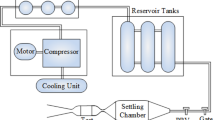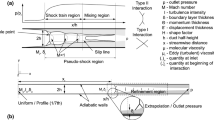Abstract
Understanding the phenomenon of Shock Wave/Boundary Layer Interaction (SBLI) is critical in developing hypersonic aircraft as it is associated with several penalties, such as huge total pressure loss, boundary layer separation, tremendous temperature rise, fluctuating pressure, and thermal load. The consequences become severe, particularly at hypersonic speeds. Thus, it is essential to control the occurrence of SBLIs to minimize these repercussions. With this in mind, the current study numerically investigates the efficacy of an array of Micro-Vortex Generators (MVGs) placed upstream and at the interaction region in the Mach 5.7 intake. The computational analysis was performed using the finite volume solver Ansys fluent and a 3-dimensional numerical model. MVGs of three different heights (0.5 mm, 0.7 mm, and 1.0 mm) were considered to understand the detailed impact of MVGs height on controlling interactions. The steady-state analysis was carried out using shear stress transport (SST) k–ω turbulence model. Besides, Delayed Detached Eddy Simulation (DES) combined with SST k-omega is specifically considered for unsteady analysis to observe the flow evolution. The quantitative and qualitative analysis has been conducted by examining the static pressure and velocity distributions over the ramp surface and visualizing the shock structures. A maximum of 9.84% reduction in wall static pressure is observed for the MVGs of 1.0 mm height when stationed at the interaction region. The MVGs of 0.7 mm height, placed upstream of the interaction region, are proved to be more efficient than other MVGs. However, pressure recovery and turbulence intensity are maximum for 0.5 mm MVGs, when deployed upstream of the interaction zone.


















Similar content being viewed by others

Availability of data and materials
All the data and materials used in the study are reported in the article itself.
Abbreviations
- SBLIs:
-
Shock wave/boundary layer interactions
- MVGs:
-
Micro-vortex generators
- SST:
-
Shear stress transport
- SBVGs:
-
Sub-boundary layer vortex generators
- 3-D:
-
3-Dimensional
- RANS:
-
Reynolds averaged Navier–Stokes
- M :
-
Mach number
- δ 0 :
-
Undisturbed boundary layer thickness
- p :
-
Wall static pressure
- p ∞ :
-
Free-stream pressure
- s :
-
Span-wise distance between micro-vortex generators
- w :
-
Width of micro-vortex generators
- L :
-
Total axial length of intake
- x :
-
Axial position on the intake
- μ :
-
Dynamic viscosity
- μ 0 :
-
Reference dynamic viscosity
- T :
-
Static temperature
- T 0 :
-
Reference temperature
References
Kaushik M (2022) Fundamentals of gas dynamics, 1st edn. Springer Nature, Singapore. https://doi.org/10.1007/978-981-16-9085-3
Kaushik M (2019) Theoretical and experimental aerodynamics, 1st edn. Springer Nature, Singapore
Babinsky H, Harvey JK (2011) Shock-wave boundary-layer interactions. Cambridge University Press, Cambridge, UK
Goldsmith EL, Seddon J (1993) Practical intake aerodynamic design, 2nd edn. American Institute of Aeronautics and Astronautics, Washington, DC
Blinde PL, Humble RA, van Oudheusden BW et al (2009) Effects of micro-ramps on a shock wave/turbulent boundary layer interaction. Shock Waves 19:507–520. https://doi.org/10.1007/s00193-009-0231-9
Keuchel B, Andrews L, Rahe C (2020) "Shock Wave and Boundary Layer Interaction." Williams Honors College, Honors Research Projects, 1138
Riley N (2013) "Shock Wave-Boundary-Layer Interactions In Shock Wave-Boundary-Layer Interactions, edited by Holger Babinsky and John K. Harvey. Contemp Phys 54(1):62–63. https://doi.org/10.1080/00107514.2012.760652
Humrutha G, Thillaikumar T, Jana T, Kaushik M (2020) Effects of wall ventilation on the shock-wave/viscous-layer interactions in a Mach 2.2 intake. Processes 8(2):208–228. https://doi.org/10.3390/pr8020208
Delery J (1985) Shock wave/turbulent boundary layer interaction and its control. Prog Aerosp Sci 22(4):209–280. https://doi.org/10.1016/0376-0421(85)90001-6
Babinsky H, Li Y, Pitt-Ford CW (2009) Micro-ramp control of supersonic oblique shock-wave/boundary-layer interactions. AIAA J 47(3):668–675. https://doi.org/10.2514/1.38022
Schulte D, Henckles A, Wepler U (1998) Reduction of shock induced boundary layer separation in hypersonic inlets using bleed. Aerosp Sci Technol 2(4):231–239. https://doi.org/10.1016/S1270-9638(98)80001-1
Lee S, Loth E, Babinsky H (2011) Normal shock boundary layer control with various vortex generator geometries. Comput Fluids 49:233–246. https://doi.org/10.1016/j.compfluid.2011.06.003
Xie WZ, Wu ZM, Yu AY, Guo S (2017) Control of severe shock-wave/boundary-layer interactions in hypersonic inlets. J Propul Power 34(October):614–623. https://doi.org/10.2514/1.b36614
Doerfer P, Szulc O (2007) Shock wave strength reduction by passive control using perforated plates. J Therm Sci 16(2):97–104
Jana T, Thillaikumar T, Kaushik M (2020) Assessment of cavity covered with porous surface in controlling shock/boundary-layer interactions in hypersonic intake. Int J Aeronaut Space Sci. https://doi.org/10.1007/s42405-020-00269-4
Pearcey H (1961) Boundary layer control for aerofoils and wings. In: Lachmann G (ed) Boundary layer and flow control: Its principles and application. Pergamon Press, Oxford, pp 1261–1333
Brown AC, Nawrocki HF, Paley PN (1968) Subsonic diffusers designed integrally with vortex generators. J Aircr 5(3):221–229. https://doi.org/10.2514/3.43931
Panaras AG, Lu FK (2015) Micro-vortex generators for shock wave/boundary layer interactions. Prog Aerosp Sci 74(December):16–47. https://doi.org/10.1016/j.paerosci.2014.12.006
Ashill P, Fulker J, Hackett K (2001) "Research at DERA on sub boundary layer vortex generators (SBVGs)." In Proceedings of the 39th Aerospace Sciences Meeting and Exhibit, Washington, DC, American Institute of Aeronautics and Astronautics
Inger G, Siebersma T (1989) Computational simulation of vortex generator effects on transonic shock/boundary-layer interaction. J Aircr 26(8):697–698. https://doi.org/10.2514/3.45826
Lin JC, Howard FG, Bushnell DM, Selby GV (1990) "Investigation of several passive and active methods for turbulent flow separation control." In Proceedings of the 21st Fluid Dynamics, Plasma Dynamics and Lasers Conference, Washington, DC, American Institute of Aeronautics and Astronautics
Anderson B, Tinapple J, Surber L (2006) "Optimal control of shock wave turbulent boundary layer interactions using micro-array actuation." In Proceedings of the 3rd AIAA Flow Control Conference, Washington, DC, American Institute of Aeronautics and Astronautics
Zhang Y, Tan H-J, Du M-C, Wang D-P (2015) Control of shock/boundary-layer interaction for hypersonic inlets by highly swept microramps. J Propul Power 31(1):133–143. https://doi.org/10.2514/1B35299
Holden H, Babinsky H (2007) Effect of micro-vortex generators on separated normal shock/boundary layer interactions. J Aircr 44(1):170–174. https://doi.org/10.2514/1.22770
Herges T, Elliott G, Dutton C, Lee, Y (2010) "Micro-vortex generators and recirculating flow control of normal shock stability and position sensitivity." In Proceedings of the 48th AIAA Aerospace Sciences Meeting including the New Horizons Forum and Aerospace Exposition, January 4–7, , Orlando, Florida
Lu FK, Li Q, Liu C (2012) Microvortex generators in high-speed flow. Prog Aerosp Sci 53(August):30–45. https://doi.org/10.1016/j.paerosci.2012.03.003
Saad MR, Zare-Behtash H, Che-Idris A, Kontis K (2012) Microramps for hypersonic flow control. Micromachines 3(2):364–378. https://doi.org/10.3390/mi3020364
Kaushik M (2019) Experimental studies on micro-vortex generator-controlled shock/boundary-layer interactions in Mach 2.2 intake. Int J Aeronaut Space Sci 20(3):584–595. https://doi.org/10.1007/s42405-019-00166-5
Jana T, Thillaikumar T, Kaushik M (2021) Micro-vortex generator controlled shock/boundary-layer interactions in hypersonic intake. J Aerosp Eng 34(2):1–13. https://doi.org/10.1061/(ASCE)AS.1943-5525.0001239
Delery J, Marvin JG (1986) Shock-wave boundary layer interactions. Cambridge University Press, Cambridge, UK
Estruch-Samper D, Vanstone L, Hillier R, Ganapathisubramani B (2015) Micro vortex generator control of axisymmetric high-speed laminar boundary layer separation. Shock Waves 25(5):521–533. https://doi.org/10.1007/s00193-014-0514-7
Jana T, Kaushik M (2022) Survey of control techniques to alleviate repercussions of shock-wave and boundary layer interactions. Adv Aerodyn. https://doi.org/10.1186/s42774-022-00119-9
Janarthanam S, Babu V (2012) Numerical simulations of the flow through the inlet and isolator of a Mach 4 dual mode scramjet. Aeronaut J 116(1182):833–846
Sudharsan NM, Jambekhar VA, Babu V (2010) A validation study of OpenFOAM using the supersonic flow in a mixed compression intake. Proceed Instit Mech Eng Part G J Aerosp Eng 224(6):673–679. https://doi.org/10.1243/09544100JAERO651
Soltani MR, Younsi JS, Farahani M (2012) Investigation of a new flux scheme for the numerical simulation of the supersonic intake flow. Proceed Instit Mech Eng Part G J Aerosp Eng 226(11):1445–1454. https://doi.org/10.1177/0954410011422634
Gupta G, Ashok Kumar A, Sivakumar R, Kandasamy J (2022) CFD investigation of shock boundary layer interaction in hypersonic flow and flow control using micro ramps. Aircr Eng Aerosp Technol 94(6):862–870. https://doi.org/10.1108/AEAT-04-2020-0069
Mogrekar A, Sivakumar R (2014) cfd analysis of micro-ramps for hypersonic flows. Appl Mech Mater 592–594:1962–1966. https://doi.org/10.4028/www.scientific.net/amm.592-594.1962
Smirnov NN, Betelin VB, Nikitin VF, Stamov LI, Altoukhov DI (2015) Accumulation of errors in numerical simulations of chemically reacting gas dynamics. Acta Astronaut 117:338–355
Smirnov NN, Betelin VB, Shagaliev RM, Nikitin VF, Belyakov IM, Deryuguin YuN, Aksenov SV, Korchazhkin DA (2014) Hydrogen fuel rocket engines simulation using LOGOS code. Int J Hydrogen Energy 39:10748–10756
Betelin VB, Kushnirenko AG, Smirnov NN, Nikitin VF, Tyurenkova VV, Stamov LI (2018) Numerical investigations of hybrid rocket engines. Acta Astronaut 144:363–370. https://doi.org/10.1016/j.actaastro.2018.01.009
Kushnirenko AG, Stamov LI, Tyurenkova VV, Smirnova MN, Mikhalchenko EV (2021) Three-dimensional numerical modeling of a rocket engine with solid fuel. Acta Astronaut 181:544–551. https://doi.org/10.1016/j.actaastro.2021.01.028
Raj CA, Narasimhavaradhan M, Vaishnavi N, Arunvinthan S, Al Arjani A, Pillai SN (2020) Aerodynamics of ducted re-entry vehicles. Chin J Aeronaut 33(7):1837–1849
Kaushikh K, Arunvinthan S, Pillai SN (2018) Aerodynamics and aerothermodynamics of undulated re-entry vehicles. Acta Astronaut 142:95–102
Janarthanam S, Babu V (2012) “Numerical simulations of the flow through the inlet and isolator of a Mach 4 dual mode scramjet. Aeronaut J 116(1182):833
Senthilkumar P, Muruganandam TM (2020) Numerical simulation of supersonic flow through scramjet intake with concavity in cowl surface. J Appl Fluid Mech 13(5):1601–1610
Crippa S (2011) Improvement of unstructured computational fluid dynamic simulations though novel mesh generation methodologies. J Aircr 48(3):1036–1044
Guvernyuk S, Simonenko M, Zubkov A (2021) Experimental study of supersonic flow around an axisymmetric annular cavity at angles of attack. Acta Astronaut 180:693–700. https://doi.org/10.1016/j.actaastro.2021.01.0
Acknowledgements
Not applicable.
Funding
Authors declare that the present study did not receive any funding.
Author information
Authors and Affiliations
Contributions
DSNB investigated the problem, analyzed the data and wrote the first draft. AKM revised the first draft. TJ edited and reviewed the first draft. MK supervised the study and edited the final version.
Corresponding author
Ethics declarations
Conflict of interest
Authors declare a no financial and non-financial competing interest.
Rights and permissions
Springer Nature or its licensor (e.g. a society or other partner) holds exclusive rights to this article under a publishing agreement with the author(s) or other rightsholder(s); author self-archiving of the accepted manuscript version of this article is solely governed by the terms of such publishing agreement and applicable law.
About this article
Cite this article
Bharghava, D.S.N., Mali, A.K., Jana, T. et al. Numerical studies on uncontrolled and controlled shock wave/boundary layer interactions in hypersonic intake. AS (2023). https://doi.org/10.1007/s42401-023-00252-3
Received:
Revised:
Accepted:
Published:
DOI: https://doi.org/10.1007/s42401-023-00252-3



